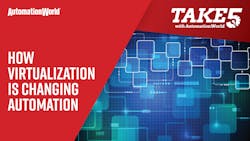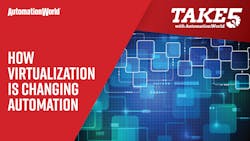How Virtualization is Changing Automation

Quick hits:
- How virtualization enables one server to perform tasks that used to require three servers.
- Find out how a CNC manufacturer uses one real-time operating system to coordinates the cutting movement of servo axes, integrated PLC functionality, and safety monitoring functions needed for CNC machine control.
- The cybersecurity value inherent in virtual machines.
Related to this episode:
- Understanding Virtualization for Industrial Automation
- Virtualization: The IT/OT Crossroads
- PMMI U offers educational employee development resources for members of the entire supply chain. Participate and learn more about its industry trainings, certifications, leadership development, career toolkit, and more.
I’m David Greenfield, Director of Content at Automation World and thanks for joining me for this Take Five episode where I’ll be highlighting virtualization and what it means for automation in the era of Industry 4.0 and the Internet of Things.
Though virtualization is a relatively new concept for industrial automation, it has a long history of use in IT applications. Essentially, it’s a way of consolidating computing resources on fewer computing hardware devices so that you can use more of the server’s computing capacity while also reducing server cooling and maintenance costs.
Red Hat, a provider of open-source IT technologies, explains virtualization this way: they say to imagine you have 3 physical servers—one of them is a mail server, another is a web server, and the other runs various legacy applications. In this scenario, each server is using only about 30% of its capacity. Without virtualization, it was easier and more reliable to just run these individual tasks on individual servers as I just described. But with virtualization, you can split the mail server, for example, into 2 unique ones that can handle independent tasks so the legacy apps can be migrated to it. This way, you’re using your computing hardware more efficiently.
The ability to virtualize computing resources has been around since the 60s, but it didn’t start to get widely used in IT circles until the early 2000s with the introduction of hypervisor technology, which takes your physical computing resources and divides them up so that virtual environments can use them. Red Hat explains that users interact with and run computations within the virtual environment on what’s typically referred to as a virtual machine. The virtual machine functions as a single data file and, like any digital file, it can be moved from one computer to another, opened in either one, and it will work the same.
So where does this all this virtualization capability fit with automation?
Let’s look at how ProCom, a Germany-based supplier of CNC machines, is using it. ProCom’s CNC machines are designed for cutting foam and fabric for everything from mattresses and furniture to suits, jeans and t-shirts. ProCom’s cutting control technologies are powered by its proprietary industrial PC-based CNC300 controller.
The newest version of this controller uses hypervisor technology to distribute individual tasks among dedicated virtual machines. In this setup, one real-time operating system coordinates the cutting movement of the servo axes, integrated PLC functionality, and safety monitoring functions needed for CNC machine control. Previously, the company had used a dedicated CNC and PLC core along with an industrial PC-based hardware platform as the human-machine interface.
Moving from this three processor, hardware-based approach for machine control to the current version required ProCom to virtualize the hardware-based multiprocessor on a multicore processor. To do this, ProCom began using Windows 10 IoT Enterprise, which is a multicore-based x86 operating system, with one to two cores dedicated to Windows, plus one core each for the PLC and CNC motion control functions. ProCom chose Real-Time Systems’ hypervisor to enable the virtualization that would separate the Windows environment used for the user interface and task preparation from the real-time functions of the CNC. Harald Müller, head of consulting and production at ProCom, said: With the Real Time Systems hypervisor technology in place, ProCom’s control systems are now scalable across Intel’s core processors and have an OPC UA interface to handle communication of operating and machine data to connected MES and ERP applications.
This is, of course, just one example of many about the growing use of virtualization in automation. If you’re interested in learning more about how virtualization is changing automation, I recommend checking out articles such as:
“Understanding Virtualization for industrial automation,” based on a presentation delivered at Inductive Automation’s Ignition Community Conference by Mike Fahrion of Advantech B+B SmartWorks.
And “Virtualization: the IT/OT Crossroads,” which focuses on the value of virtualization in operations technology applications where computing resources are not updated as often as they are in the IT realm. It also discusses the added cybersecurity value obtainable via virtualization.
So, I hope you enjoyed this Take Five with Automation World episode and remember to keep watching this space for new episodes each week to help keep you on top of what’s happening in the world of industrial automation.
